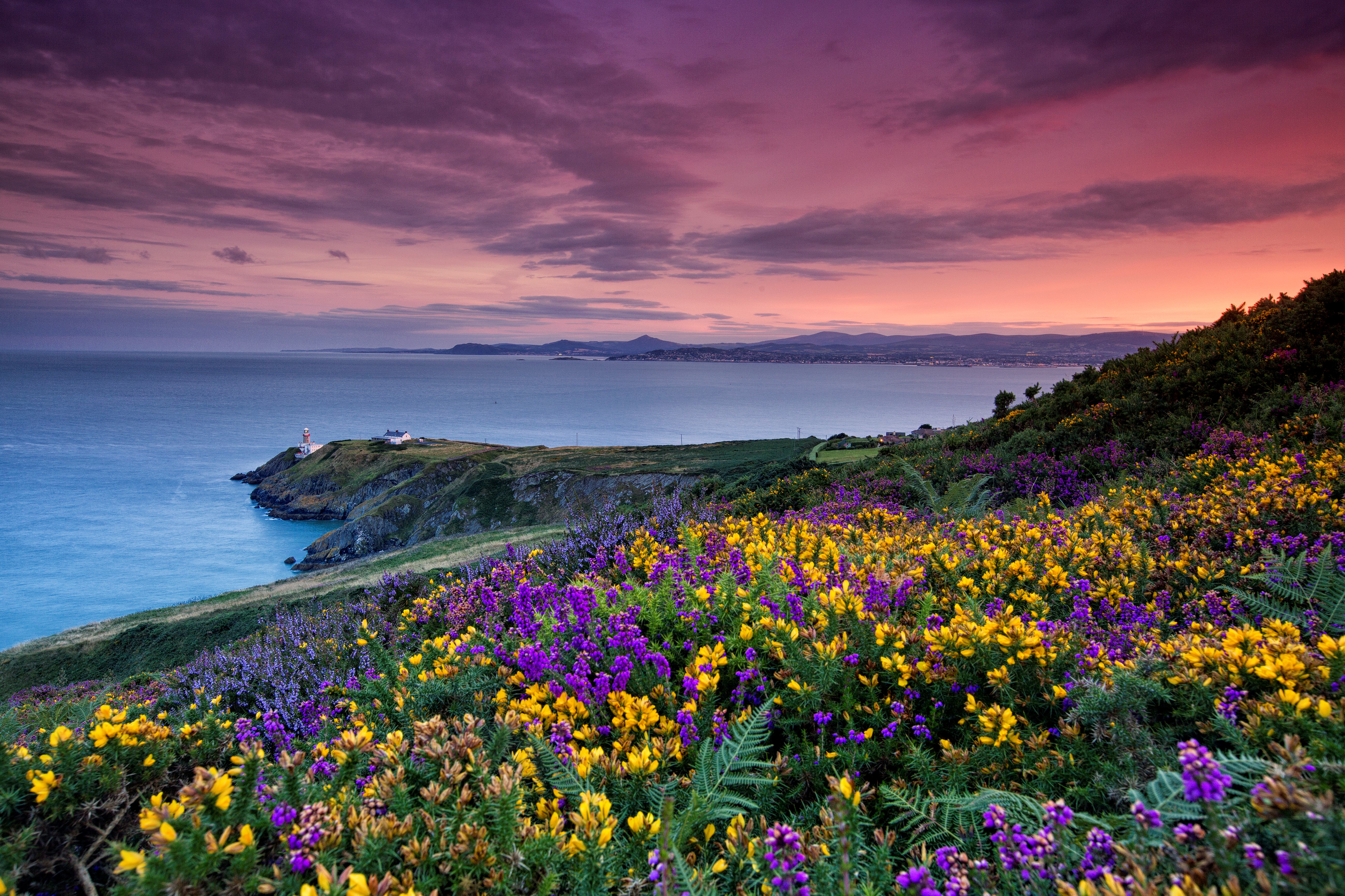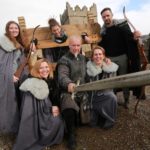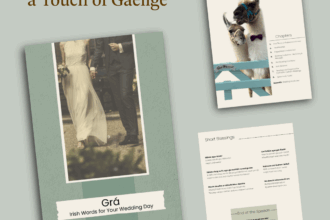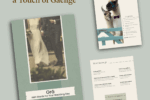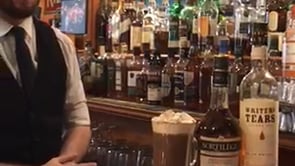Off the beaten track from dazzling light shows to amazing architecture…
Going off the beaten track in Ireland is worth it. There’s a whole host of special places to discover, from impossibly beautiful little harbours to vast, undiscovered peninsulas, iconic castle ruins to ancient bog bodies. There’s even what locals call a magic road…
The delightful north of Ireland
Secret wonders abound in the north of Ireland. Meander from Donegal to Down and discover all that this place has to offer – castles in Antrim, the Aurora Borealis in Donegal, ancient burial grounds in Armagh: oh, and the origins of some very famous writers…
Dancing with the Northern Lights
Inishowen on the Wild Atlantic Way is remote, beautiful – and THE place to witness the Northern Lights in Ireland. Bring along a flask of hot chocolate, snuggle under a blanket and watch this phenomenon at Grianán of Aileach, a huge 2,000-year-old ring fort sitting 250 metres/820ft above sea level. It’s a spectacular sight for sure! When you’ve had your fill of wonder, pop over to Buncrana to the delicious Beach House restaurant, which serves award-winning food in an incredible location.
IF YOU HAVE MORE TIME
Drop into the Inishowen Maritime Museum & Planetarium for a fascinating history of sea and sky.
Dunseverick Castle: ancient splendour atop a cliff
The Causeway Coast boasts epic sights that are famous the world over, including the Giant’s Causeway and the Carrick-a-Rede rope bridge. One of the unsung heroes, though, has to be Dunseverick Castle. A dramatic and crumbling ruin, Dunseverick’s location on top of a cliff adds a gravitas worthy of its eventful past. St Patrick is thought to have visited in the 5th century, a Viking invasion came to its door in 870 AD; and the castle was captured and destroyed in the 1600s. The fact that any of it has survived is something of a miracle.
IF YOU HAVE MORE TIME
Head to the nearby Bushmills Inn restaurant for traditional fare with a twist.
Hidden treasure on Divis and the Black Mountain
Looking for a wild countryside experience? The gorgeous National Trust site of Divis and the Black Mountain is it. Think free-roaming cattle in green fields, wild horses and badger setts. Keep an eye out for rare birds, too – peregrine falcons are known to frequent this spot. Pick a clear day, and your view will include Strangford Lough, the Mourne Mountains, the Sperrin Mountains and even Scotland. Bliss.
Image courtesy of Outdoor NI.
DON’T MISS
It’s not quite off the beaten track, but if you’re anywhere near Belfast city, Titanic Belfast is an essential experience.
Ancient skulls at a pagan fort
Named after the pagan goddess Queen Macha, who, according to legend, ruled for over a decade in this part of the world, Navan Fort (Emain Macha in Irish) was once the high seat of the kings and queens of Ulster. Archaeologists love this place, thanks to finds such as the 2,500-year-old skull of a Barbary macaque monkey, which found its way there from North Africa.
IF YOU HAVE MORE TIME
Reserve a table at The Moody Boar, secreted away in the beautiful Armagh Palace Demesne. Enjoy chicken, haddock or steak with a hearty local cider.
Enjoy the sound of silence
The shimmering heart of the Mourne Mountains, the Silent Valley reservoir is a magnet for busy minds yearning for solitude. If you want to get away from it all, this is the place to go. Ringed by mountains, the man-made lake isn’t called “silent” for nothing. The tranquillity here makes it a perfect spot for chilling out and reflecting on your journey.
IF YOU HAVE MORE TIME
The Brontë Homeland Drive brings you to the tiny church where Patrick Brontë – father to Charlotte, Anne and Emily – was born and raised.
Magic in Ireland’s Ancient East
Ireland’s Ancient East is renowned for its long history of amazing stories – ask any local about the area you’re in and you’ll see what we mean. But three spots in County Louth and County Kildare take the crown for quirky stories you’ll never forget…
Roll up the Magic Road
The “magic road” is legendary among locals in Jenkinstown, County Louth, and rightly so. Take a car to this unassuming little spot, stop at what is affectionately known as “the Big Mushroom”, shift gear into neutral and prepare to defy gravity – literally – as your car rolls uphill!
IF YOU HAVE MORE TIME
Fancy an adrenaline rush? Head to Carlingford Adventure Centre and try rock-climbing, zorbing and laser tag in this picturesque area.
Get up close with nature at Lullymore Heritage Park
Meander through the tree-lined roads that surround Lullymore Heritage and Discovery Park, and you’ll find yourself in another world. Once a monastic retreat (until it was ransacked during a rebellion in the early 18th century), the park is now a celebration of the Irish peatlands. A biodiversity tour introduces the amazing flora and fauna of the area – watch out for the Irish hare!
IF YOU HAVE MORE TIME
Head to Harte’s Bar and Grill in Kildare town for award-winning food in relaxed surroundings with tasty gastropub-style dishes.
The weird and the wonderful
Ever seen a barn that’s shaped like a corkscrew? Well, you have now! The Wonderful Barn in County Kildare was built to create employment in the local area, all the way back in 1743. Towering above its surroundings at 22 metres/72ft high, the barn hides a crow’s nest viewing gallery – the whole thing is a serious feat of engineering.
Image courtesy of Gary Boggan.
DON’T MISS
If you haven’t realised already, you’ve been time travelling through Ireland’s Ancient East… take a look at where you can eat, sleep and explore around here.
The Wild Atlantic Way’s hidden gems
There’s magic in the air between Mayo and Clare – stony bridges and unusual churches are just two of the curiosities on this part of the Wild Atlantic Way. Listen up: these counties have some of the greatest stories to tell on the island…
Walk along Louisburg’s quirky clapper bridge
West of the town of Louisburgh in the rural heart of County Mayo is a curious bridge that was made to bring walkers over a wide, shallow river. Using a design called “clapper”, which is thought to be Roman in origin, the bridge is made up of 37 arches with a flat slab of limestone resting on smaller stony piers. While it may look ancient, Mayo’s bridge – which is the largest of its kind in Ireland at 130 metres/50ft long – was created around the 1840s by a local Church of Ireland community.
IF YOU HAVE MORE TIME
Visit The Tavern in nearby Murrisk for delicious local seafood dishes.
The Bog Bodies of Cnoc Suain
Cnoc Suain (meaning “quiet hill”) is a restored 17th century village in Spiddal set in 200 acres of Connemara’s rolling bogland. Here you’ll find an ancient patch of ground, where perfectly preserved bog bodies have been found. It is also currently home to the wonder plant, sphagnum moss, which can hold over 20 times its own body weight in water.
IF YOU HAVE MORE TIME
Drop into An Crúiscín Lán in Spiddal for a filling meal and – if you’re lucky – a traditional music session.
No man’s land at The Church of the Little Ark
It’s 1839 in a small parish in West Clare and the local population is suffering with a cholera outbreak. A priest called Father Michael Meehan is sent to attend to dying victims, but finds himself without a church as local landlords refuse to allow one to be built on their lands. Father Meehan’s response? In 1852, the determined priest arranges for a local carpenter to build a wooden box on wheels, which is rolled on to the beach at low tide to give mass to the locals. Eventually in 1857, a solid church is built, known as the Church of the Little Ark. The original “Little Ark” has lasted all this time, and can be visited in it new home within the church – a testament to Father Meehan’s fortitude.
IF YOU HAVE MORE TIME
Drop into the Kilbaha Gallery for a look at some of the region’s finest art and design.
Your adventure continues…
Counties Kerry and Cork are two of Ireland’s largest – and they really pack the sights in. From the tiniest churches to the highest mountain, this part of the Wild Atlantic Way is simply enchanting.
Take a very crooked road to Dunquin Harbour
The beautiful Blasket Islands – which were abandoned in the 1950s – are accessed by what has to be one of the most picturesque harbours in Ireland, Dunquin. Blasket Islanders would arrive here having crossed the turbulent Atlantic Ocean in their wooden currachs (traditional boats), making the harbour a vital access point for supplies. Times have changed, however – and while you can now catch a ferry to the island from Dunquin, the harbour has been remodelled and its (very) crooked path juts starkly out of the cliff face. This is a place that has a real edge-of-the-world feel, with the ocean swirling below and the cliffs soaring above. Afterwards, take shelter in The Blasket Centre in Dunquin village, where you can find out more about the life of the islanders.
IF YOU HAVE MORE TIME
Rest awhile in Kruger’s Bar, the most south-westerly pub in Europe.
A hidden gem in West Cork’s Gougane Barra
Want to know a secret? Cork’s idyllic Gougane Barra Forest Park shelters the prettiest little church you will ever see. Right by a lake sits St Finbarr’s Oratory, close to a former 6th century monastery. Unsurprisingly, this little church is a popular wedding location. Just look at those views…and think of the wedding album.
IF YOU HAVE MORE TIME
Relax with dinner in the Gougane Barra Hotel. The stunning location with its gorgeous views of the lake is matched with excellent food in its AA Rosette restaurant.
Sway gently over the waves at Dursey Island
Do you want to head way off the grid on this adventure? Congratulations, we’ve found you the right spot. Head to Dursey Island off the coast of County Cork, accessible by Ireland’s only cable car – and one of the few cable cars in Europe that traverses open sea. The car is a lifeline for Dursey’s handful of inhabitants, who use it to cross over to the rest of the world. If you can handle looking down, you may spot dolphins and whales playing amongst the waves!
DON’T MISS
The next stop on your adventure? Why, a galaxy far, far away of course… Head to the 6th century monastic retreat of Skellig Michael, where Star Wars: The Force Awakens was filmed.
Source:Ireland.com

